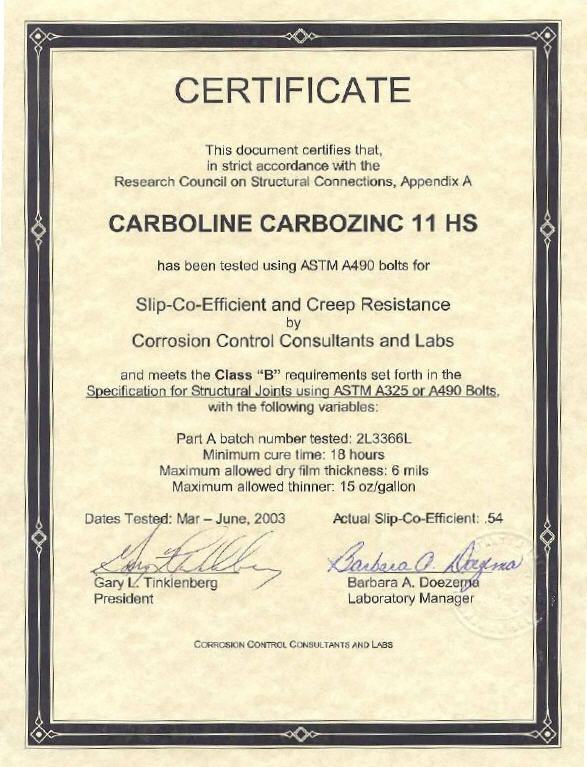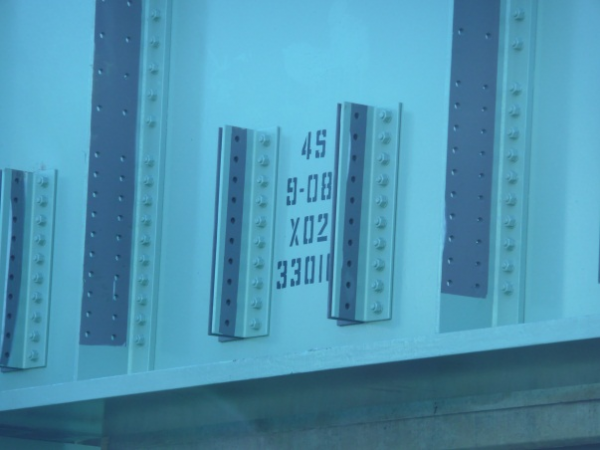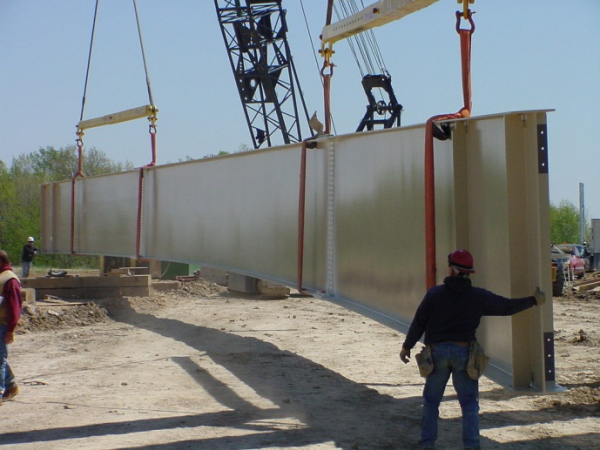Difference between revisions of "716 - Shop Cleaning and Coating Structural Steel"
| (7 intermediate revisions by 2 users not shown) | |||
| Line 7: | Line 7: | ||
| − | + | ==[[#GENERAL|GENERAL]]== | |
This section refers to the process of shop cleaning and coating new structural steel, and the repairing of coating surfaces that may be damaged during the erection process or construction. If more than 500 square feet of structural steel is to be shop coated, the fabricator must have an AISC Sophisticated Paint Endorsement or SSPC QP3 Shop Painting Certification. | This section refers to the process of shop cleaning and coating new structural steel, and the repairing of coating surfaces that may be damaged during the erection process or construction. If more than 500 square feet of structural steel is to be shop coated, the fabricator must have an AISC Sophisticated Paint Endorsement or SSPC QP3 Shop Painting Certification. | ||
| Line 14: | Line 14: | ||
{{top}} | {{top}} | ||
| − | + | ===[[#Shop Cleaning and Coating|Shop Cleaning and Coating]]=== | |
A three coat paint system similar to field painting applications must be used. The three coat system consists of an organic or inorganic zinc primer, an epoxy intermediate coat, and a polyurethane top coat. Organic zinc primers must be used in field applications. Organic or inorganic coatings may be used in shop applications. This is due to the temperature sensitivity of inorganic zinc primer. Shop coating has greater controls related to temperature and humidity, thus inorganic is allowed. This also has to do with slip critical connections. Organic zinc primers require a 100 hour cure time for slip critical applications, whereas, inorganic primers only require an 18 hour cure time for similar applications. | A three coat paint system similar to field painting applications must be used. The three coat system consists of an organic or inorganic zinc primer, an epoxy intermediate coat, and a polyurethane top coat. Organic zinc primers must be used in field applications. Organic or inorganic coatings may be used in shop applications. This is due to the temperature sensitivity of inorganic zinc primer. Shop coating has greater controls related to temperature and humidity, thus inorganic is allowed. This also has to do with slip critical connections. Organic zinc primers require a 100 hour cure time for slip critical applications, whereas, inorganic primers only require an 18 hour cure time for similar applications. | ||
| Line 21: | Line 21: | ||
Refer to [http://mdotcf.state.mi.us/public/specbook/files/2012/715%20Clean,%20Coat%20Exist%20Str%20St.pdf section 715] and [http://mdotcf.state.mi.us/public/specbook/files/2012/716%20Shop%20Clean,%20Coat%20Str%20St.pdf section 716] of the Standard Specifications for Construction and section 715 of the Construction Manual for specifics related to the coating application. | Refer to [http://mdotcf.state.mi.us/public/specbook/files/2012/715%20Clean,%20Coat%20Exist%20Str%20St.pdf section 715] and [http://mdotcf.state.mi.us/public/specbook/files/2012/716%20Shop%20Clean,%20Coat%20Str%20St.pdf section 716] of the Standard Specifications for Construction and section 715 of the Construction Manual for specifics related to the coating application. | ||
| + | {{top}} | ||
| − | + | ====[[#Faying Surfaces and Slip Critical Connections|Faying Surfaces and Slip Critical Connections]]==== | |
Faying surfaces are those surfaces which will be in contact with other structural steel members, such as diaphragm connections and bolted splices. These surfaces only receive a zinc prime coat prior to the bolted connection. After bolting of the steel members has occurred the final two coats must be applied. | Faying surfaces are those surfaces which will be in contact with other structural steel members, such as diaphragm connections and bolted splices. These surfaces only receive a zinc prime coat prior to the bolted connection. After bolting of the steel members has occurred the final two coats must be applied. | ||
Slip critical connections are those faying surfaces which rely on the friction of the primed surface as part of the structural capacity. Bolted beam splices are an example of a slip critical connection. Slip critical connections only receive the zinc prime coat. The intermediate coat and top coat do not provide adequate friction. | Slip critical connections are those faying surfaces which rely on the friction of the primed surface as part of the structural capacity. Bolted beam splices are an example of a slip critical connection. Slip critical connections only receive the zinc prime coat. The intermediate coat and top coat do not provide adequate friction. | ||
| Line 30: | Line 31: | ||
[[File:Fig716.02.png|600px|thumb|center|Figure 716.02 Faying surfaces and stenciling]] | [[File:Fig716.02.png|600px|thumb|center|Figure 716.02 Faying surfaces and stenciling]] | ||
| + | {{top}} | ||
| − | + | ====[[#Other Connections|Other Connections]]==== | |
The faying surfaces should receive the same prime coat material that will be used in the field. Slip critical connections are the exception. Slip critical connections require the inorganic Class B slip coefficient prime coat. Prior to applying the intermediate and top coats, mask the faying surface. After the structural steel has been erected, the faying surfaces must be solvent cleaned and coated with the same intermediate and top coats used for the remainder of the structure. | The faying surfaces should receive the same prime coat material that will be used in the field. Slip critical connections are the exception. Slip critical connections require the inorganic Class B slip coefficient prime coat. Prior to applying the intermediate and top coats, mask the faying surface. After the structural steel has been erected, the faying surfaces must be solvent cleaned and coated with the same intermediate and top coats used for the remainder of the structure. | ||
| − | + | {{top}} | |
| + | |||
| + | ====[[#Stenciling|Stenciling]]==== | ||
Apply stenciling in accordance with subsection [http://mdotcf.state.mi.us/public/specbook/files/2012/715%20Clean,%20Coat%20Exist%20Str%20St.pdf 715.03.D.5 of the Standard Specifications for Construction]. | Apply stenciling in accordance with subsection [http://mdotcf.state.mi.us/public/specbook/files/2012/715%20Clean,%20Coat%20Exist%20Str%20St.pdf 715.03.D.5 of the Standard Specifications for Construction]. | ||
| + | {{top}} | ||
| + | |||
| + | |||
| + | ====[[#Galvaninizing|Galvaninizing]]==== | ||
| + | Hot-dipped galvanizing is an acceptable alternative to the zinc primer for structural steel members, except for surfaces internal to slip critical locations, as the slip coefficient is not sufficient. Galvanize according to [http://mdotcf.state.mi.us/public/specbook/files/2012/716%20Shop%20Clean,%20Coat%20Str%20St.pdf subsection 716.03.B.4 of the Standard Specifications for Construction.] | ||
| + | |||
| + | {{top}} | ||
| + | |||
| + | ==[[#MATERIALS|MATERIALS]]== | ||
| − | + | <span style="color: red"> -Reserved- </span> | |
| − | |||
{{top}} | {{top}} | ||
| + | |||
| + | ==[[#CONSTRUCTION|CONSTRUCTION]]== | ||
====[[#Storage and Handling|Storage and Handling]]==== | ====[[#Storage and Handling|Storage and Handling]]==== | ||
| Line 51: | Line 65: | ||
The Inspector should verify that care is taken during the handling and erection process so that no damage occurs to the components. Ensure the contractor uses softeners approved by the engineer during picks that require binding chains or other metallic lifting devices. In the event that the components are to be stored on site prior to erection, the storage method should be inspected to ensure that no damage occurs to the components during this period of time. | The Inspector should verify that care is taken during the handling and erection process so that no damage occurs to the components. Ensure the contractor uses softeners approved by the engineer during picks that require binding chains or other metallic lifting devices. In the event that the components are to be stored on site prior to erection, the storage method should be inspected to ensure that no damage occurs to the components during this period of time. | ||
| − | Upon completion of the erection process the entire structure should be visually inspected for damage and all areas marked and documented. All repairs should be done in compliance with Section 716.03.D of the Standard Specifications. | + | Upon completion of the erection process the entire structure should be visually inspected for damage and all areas marked and documented. All repairs should be done in compliance with [http://mdotcf.state.mi.us/public/specbook/files/2012/716%20Shop%20Clean,%20Coat%20Str%20St.pdf%20 Section 716.03.D of the Standard Specifications]. |
[[File: Fig716.04.png|600px|thumb|center|Figure 716.04 Proper handling with lifting straps]] | [[File: Fig716.04.png|600px|thumb|center|Figure 716.04 Proper handling with lifting straps]] | ||
| Line 62: | Line 76: | ||
Cleaning and coating of field damage to the shop applied coating system must be done in accordance with [http://mdotcf.state.mi.us/public/specbook/files/2012/715%20Clean,%20Coat%20Exist%20Str%20St.pdf section 715 of the Standard Specifications for Construction.] This pay item is established as a lump sum pay item and is used to pay for any damage to the shop applied coating during transport, handling, and erection as well to apply the intermediate and top coats to galvanized components (nuts, bolts, washers, etc.) and primed faying surfaces. Ensure the contractor adequately coats all elements of beam repairs or new diaphragm connection gusset plates and hardware. | Cleaning and coating of field damage to the shop applied coating system must be done in accordance with [http://mdotcf.state.mi.us/public/specbook/files/2012/715%20Clean,%20Coat%20Exist%20Str%20St.pdf section 715 of the Standard Specifications for Construction.] This pay item is established as a lump sum pay item and is used to pay for any damage to the shop applied coating during transport, handling, and erection as well to apply the intermediate and top coats to galvanized components (nuts, bolts, washers, etc.) and primed faying surfaces. Ensure the contractor adequately coats all elements of beam repairs or new diaphragm connection gusset plates and hardware. | ||
When painting the final two coats of the primed faying surfaces the surface must be solvent cleaned to remove contaminates. Galvanized components do not require an additional prime coat, as the galvanizing is the sacrificial coating in lieu of the zinc-rich primer. Galvanized components do require a tie coat that will bond the intermediate and top coats. The tie coats are typically epoxy intermediate coats as well. The information regarding whether or not an approved epoxy intermediate paint is also a tie coat can be found in the products’ technical data sheets. | When painting the final two coats of the primed faying surfaces the surface must be solvent cleaned to remove contaminates. Galvanized components do not require an additional prime coat, as the galvanizing is the sacrificial coating in lieu of the zinc-rich primer. Galvanized components do require a tie coat that will bond the intermediate and top coats. The tie coats are typically epoxy intermediate coats as well. The information regarding whether or not an approved epoxy intermediate paint is also a tie coat can be found in the products’ technical data sheets. | ||
| − | |||
| − | |||
| − | |||
| − | |||
| − | |||
| − | |||
| − | |||
| − | |||
| − | |||
| − | |||
{{top}} | {{top}} | ||
| Line 82: | Line 86: | ||
[[Category:Construction Manual]] | [[Category:Construction Manual]] | ||
| + | [[Category: Division 7]] | ||
| + | [[Category: Section 716]] | ||
Revision as of 16:36, 12 May 2021
GENERAL
This section refers to the process of shop cleaning and coating new structural steel, and the repairing of coating surfaces that may be damaged during the erection process or construction. If more than 500 square feet of structural steel is to be shop coated, the fabricator must have an AISC Sophisticated Paint Endorsement or SSPC QP3 Shop Painting Certification. All shop coated steel will be inspected by MDOT and stamped with an approval. Field staff should verify the approval prior to acceptance of the structural steel. All shop cleaning and coating must be done in accordance with section 716 of the Standard Specifications for Construction.
Shop Cleaning and Coating
A three coat paint system similar to field painting applications must be used. The three coat system consists of an organic or inorganic zinc primer, an epoxy intermediate coat, and a polyurethane top coat. Organic zinc primers must be used in field applications. Organic or inorganic coatings may be used in shop applications. This is due to the temperature sensitivity of inorganic zinc primer. Shop coating has greater controls related to temperature and humidity, thus inorganic is allowed. This also has to do with slip critical connections. Organic zinc primers require a 100 hour cure time for slip critical applications, whereas, inorganic primers only require an 18 hour cure time for similar applications.
Refer to section 715 and section 716 of the Standard Specifications for Construction and section 715 of the Construction Manual for specifics related to the coating application.
Faying Surfaces and Slip Critical Connections
Faying surfaces are those surfaces which will be in contact with other structural steel members, such as diaphragm connections and bolted splices. These surfaces only receive a zinc prime coat prior to the bolted connection. After bolting of the steel members has occurred the final two coats must be applied. Slip critical connections are those faying surfaces which rely on the friction of the primed surface as part of the structural capacity. Bolted beam splices are an example of a slip critical connection. Slip critical connections only receive the zinc prime coat. The intermediate coat and top coat do not provide adequate friction. Ensure the contractor properly cleans the surface of the members to be connected prior to field assembly. Connection bolts are to be tightened by turn-of-nut method in accordance with subsection 707.03.D.7.c of the Standard Specifications for Construction. The primer must meet the requirements of Class B slip coefficient, which will determine the minimum dry film thickness. Refer to subsection 716.03.B.2 of the Standard Specifications for Construction.
Other Connections
The faying surfaces should receive the same prime coat material that will be used in the field. Slip critical connections are the exception. Slip critical connections require the inorganic Class B slip coefficient prime coat. Prior to applying the intermediate and top coats, mask the faying surface. After the structural steel has been erected, the faying surfaces must be solvent cleaned and coated with the same intermediate and top coats used for the remainder of the structure.
Stenciling
Apply stenciling in accordance with subsection 715.03.D.5 of the Standard Specifications for Construction.
Galvaninizing
Hot-dipped galvanizing is an acceptable alternative to the zinc primer for structural steel members, except for surfaces internal to slip critical locations, as the slip coefficient is not sufficient. Galvanize according to subsection 716.03.B.4 of the Standard Specifications for Construction.
MATERIALS
-Reserved-
CONSTRUCTION
Storage and Handling
Upon arrival at the job site the Inspector must verify the structural steel components bear an MDOT inspection stamp. Typically this is found on all major components on an individual basis (each beam, etc) but in cases where there are multiple components shipped as one unit the stamp may be found on only one component. If there is any question as to whether or not the components have been inspected and are in compliance, a further investigation should be initiated. Contact Bridge Field Services, Structural Fabrication Unit for questions regarding MDOT inspection of steel components. All components should be visually inspected upon arrival and before they are unloaded from the transport vehicle. Any damage or improper coating should be marked and documented prior to unloading. Damaged areas that are not accessible in final position will need to be repaired prior to erection.
The Inspector should verify that care is taken during the handling and erection process so that no damage occurs to the components. Ensure the contractor uses softeners approved by the engineer during picks that require binding chains or other metallic lifting devices. In the event that the components are to be stored on site prior to erection, the storage method should be inspected to ensure that no damage occurs to the components during this period of time.
Upon completion of the erection process the entire structure should be visually inspected for damage and all areas marked and documented. All repairs should be done in compliance with Section 716.03.D of the Standard Specifications.
Field Repair of Damage Coating
Cleaning and coating of field damage to the shop applied coating system must be done in accordance with section 715 of the Standard Specifications for Construction. This pay item is established as a lump sum pay item and is used to pay for any damage to the shop applied coating during transport, handling, and erection as well to apply the intermediate and top coats to galvanized components (nuts, bolts, washers, etc.) and primed faying surfaces. Ensure the contractor adequately coats all elements of beam repairs or new diaphragm connection gusset plates and hardware. When painting the final two coats of the primed faying surfaces the surface must be solvent cleaned to remove contaminates. Galvanized components do not require an additional prime coat, as the galvanizing is the sacrificial coating in lieu of the zinc-rich primer. Galvanized components do require a tie coat that will bond the intermediate and top coats. The tie coats are typically epoxy intermediate coats as well. The information regarding whether or not an approved epoxy intermediate paint is also a tie coat can be found in the products’ technical data sheets.
MEASUREMENT AND PAYMENT
-Reserved-



